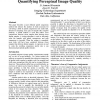Free Online Productivity Tools
i2Speak
i2Symbol
i2OCR
iTex2Img
iWeb2Print
iWeb2Shot
i2Type
iPdf2Split
iPdf2Merge
i2Bopomofo
i2Arabic
i2Style
i2Image
i2PDF
iLatex2Rtf
Sci2ools
PICS
1998
1998
Quantifying Perceptual Image Quality
This paper describes a more efficient paired comparison method that reduces the number of trials necessary for converting a table of paired comparisons into scalar data. Instead of comparing every pair of samples (the complete method), a partial method is used that makes more comparisons between closer samples than between more distant samples. A sorting algorithm is used to efficiently order the samples with paired comparisons, and each comparison is recorded. When the sorting is completed, more trials will have been conducted between closer samples than between distant samples. A regression is used to scale the resulting comparison matrix into a one dimensional perceptual quality estimate.
| Added | 01 Nov 2010 |
| Updated | 01 Nov 2010 |
| Type | Conference |
| Year | 1998 |
| Where | PICS |
| Authors | D. Amnon Silverstein, Joyce E. Farrell |
Comments (0)

